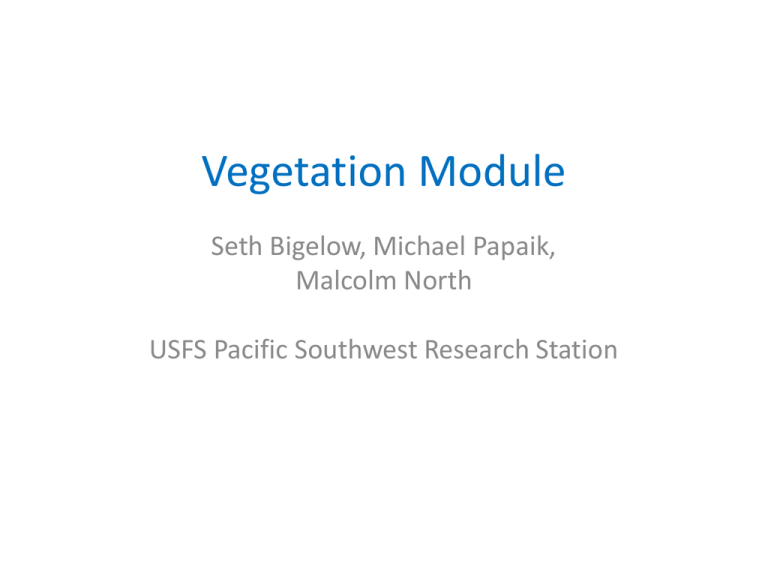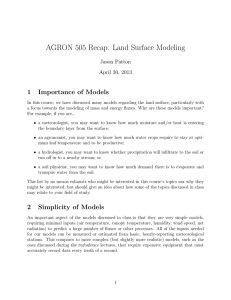Vegetation Module Seth Bigelow, Michael Papaik, Malcolm North USFS Pacific Southwest Research Station
advertisement

Vegetation Module Seth Bigelow, Michael Papaik, Malcolm North USFS Pacific Southwest Research Station Canopy Cover as Management Metric • Hundreds of mentions in Sierran forest plans • Determines understory light & microclimate • Related to ecosystem service provision: water yields, biodiversity, fire regime. Forested Areas Treated in Meadow Valley, 2000-2009 How has canopy cover changed in areas treated since HFQLG implementation? Canopy Cover Change in Treated Areas Meadow Valley CA, 2002 - 2009 0 50-60 Legend Grey bar & strip title show earlier (2000) cover class. 20 40 60 80 60-70 Acres 800 600 400 Blue dots show how area is classified in 2009 200 70-80 80-90 800 600 400 200 0 20 40 60 80 Cover From Above (%) Results Many formerly high-cover areas now classified as having lower cover (Aerial photo analysis, USFS Remote Sensing Lab) PSW Experiment, Meadow Valley 2007 • Treatments: light thinning (57% CC), heavy thinning (49%), group with reserves (12%) • 12 stands, each ~ 22 acres • Microclimate measurements: fuel & soil wetness, soil temperature. • Statistical modeling of relationship between canopy cover & microclimate 10-hr Fuel Wetness & Canopy Openness Results: Negligible effect of canopy openness on fuel wetness Midday Soil Temperature & Canopy Openness 2 cm depth, mineral soil Celsius to Fahrenheit 15 C = 59 F 25 C = 77 F Day of Year: Aug 1 - 31 = 213 - 243 Results Large linear increase in midday soil temperature as canopy openness increases Soil Wetness at Three Depths Depths 0 – 15 cm (0 - 6 in) 15 – 40 cm (6 – 16 in) 40 – 70 cm (16 – 28 in ) Units Volume of water per volume of soil (m3 / m3) Expectation: Increased soil wetness after thinning, because of decreased transpiration. Soil Wetness & Canopy Openness 40-70 cm 15-40 cm 0-15 cm Results: Deeper soils are wetter No increase in soil wetness with thinning, only with group selection Conclusions: Fire Implications • US Forest Service’ fuels/forest health treatments are lowering canopy cover • More open forests will not increase fire behavior by drying out fuels… • …but hotter soils (& fuels) may increase probability of accidental ignition. Ecosystem Services & Health • Findings don’t support the notion that thinning trees will increase water yields, an important ecosystem service •Unchanged soil wetness after thinning stands means more water per tree, thus improved plant water status & resilience. Now on to Michael Papaik’s presentation…







